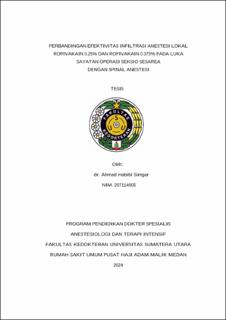Perbandingan Efektivitas Infiltrasi Anestesi Lokal Ropivakain 0.25% dan Ropivakain 0.375% pada Luka Sayatan Operasi Seksio Sesarea dengan Spinal Anestesi
Comparison of The Effectiveness of Local Anesthetic Infiltration of 0.25% Ropivacaine and 0.375% Ropivacaine on Cesarean Section Incision with Spinal Anesthesia

Date
2024Author
Siregar, Ahmad Habibi
Advisor(s)
Hamdi, Tasrif
Nadeak, Rommy F
Metadata
Show full item recordAbstract
Background: Postoperative pain after a caesarean section impacts recovery and needs effective treatment. Ropivacaine is a local anesthetic used to manage this pain, but there is limited comparison between its 0.25% and 0.375% concentrations.
Methods: This randomized controlled trial included 60 patients caesarean section with spinal anesthesia at Haji Adam Malik Medan Hospital RS Haji Medan, Rumah Sakit Prof. Chairuddin P. Lubis USU dan Rumkit TK-II Putri Hijau Medan.. Patients were divided into three groups: ropivacaine 0.25% (n=20), ropivacaine 0.375% (n=20), and a control group (n=20). Pain was measured using the Numerical Rating Scale (NRS) at 2, 6, 12, and 24 hours after surgery. Additional analgesic use and side effects were also recorded. Data were analyzed with the Kruskal-Wallis test (p<0.05).
Results: At T1, there was no significant difference between the groups (p=0.219). However, at T2,T3 and and T4, pain was significantly lower in the ropivacaine groups compared to the control group (p<0.001), but no difference was found between ropivacaine 0.25% and 0.375%. The need for additional fentanyl at T2 was higher in the control group (n=8) compared to the ropivacaine 0.25% (n=3) and ropivacaine 0.375% (n=2) groups. No side effects were reported in any of the groups.
Conclusion: Both 0.25% and 0.375% ropivacaine effectively reduce postoperative pain and the need for additional analgesics compared to control group. However, there was no significant difference between two ropivacaine concentrations.
Collections
- Master Theses [177]
